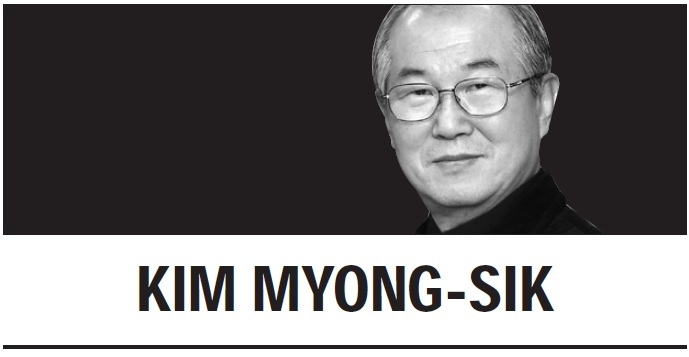[Kim Myong-sik] A tale of two migratory bird sanctuaries
By Korea HeraldPublished : Feb. 24, 2022 - 05:30

The Gimpo delta is on the migration route of birds from Siberia and Alaska to Japan and Southeast Asia. The Gimpo-Han River Ecological Park was created on a plot of about 660,000 square meters between the river and the apartment blocks. Over the years however, the number of aerial guests decreased as residents grew along with their vehicles.
So the city authorities hatched a grand plan -- they would lure birds with feed. They turned about 80,000 square meters of the park space into rice paddies. Last fall, Gimpo City Hall harvested 70 tons of rice for the first time.
When I took a walk to the park last week, I spotted piles of the brownish grain strewn on the dried paddy field, the evidence of an anxious environmental protection campaign using the staple food grain that Koreans have historically considered vital for their survival. Yet, as if suspicious of the humans’ intent, the birds that looked like mallards or wild geese were not yet devouring the free meal, while local magpies were happy to enjoy the feast.
Visiting the park again a few days later, I found the mounds of rice were all gone. Park tenders told me that the “feed” was quickly consumed by the birds that probably were now in flight to a Southeast Asian destination. City officials have accomplished their purpose and must be hoping that these birds will fly here again next winter remembering the warm treatment they had at Korea’s Han River basin.
Two-hundred kilometers to the south, we have a different story in the Saemangeum area of North Jeolla Province, the largest tideland reclamation site. Local authorities are fighting hard battles against migratory birds that are threatening an ambitious solar energy program. Solar panels initially installed in the Saemangeum Lake have been rendered almost useless as bird droppings covered their surface.
Korea plans to lay more than 5 million solar panels on the 28-square-kilometerlake to turn it into the biggest single solar power generation facility in the nation. But, regardless of its size, the serviceability of the Saemangeum solar power station will hinge on how the problem of bird droppings is taken care of.
The Saemangeum Development and Investment Agency and the Korea Testing Laboratory have jointly worked to find ways to protect the solar panels against the invaders from the air. Among solutions so far studied are: Flying numerous kites of monstrous designs that could scare the migratory birds away; firing deadly laser beams; and sounding low-frequency noise to disturb the birds’ nervous system.
Even while these methods were being examined, the authorities of the Ministry of Environment interfered, cautioning against actions that would harm the global eco system. Environmental warnings had already been given to solar energy businesses when they applied for permissions to build power generation facilities. Even installing nets above the panels is prohibited.
The contradictory fates of migratory birds up and down the west coast reflect the complexity of environment-related problems involving development projects in South Korea as in most other countries today, which have grown to seize political agenda. Here, leftist politics succeeded in monopolizing environmental issues as they challenged the right-wingers for their business-friendly stance supposedly neglecting the cause of protecting nature.
As conservatives and progressives have exchanged power in roughly 10-year cycles since the 1990s, major infrastructure projects were rushed or slowed down, depending on the degree of sympathy offered for environmental activists by the government in power. For example, construction of a northern 10 km section of Highway No. 100 circling the capital city of Seoul, begun in 2001, was delayed by two years as Buddhist and environmentalist groups interrupted building a tunnel which they claimed damaged the scenery and serenity of the mountainous area.
In a similarly controversial high-speed railway project near Busan, Buddhist nun Jiyul played the key role in halting the work under Cheonseongsan for nearly three years from 2003 to 2006 with hunger strikes and numerous injunction suits. She sued the government, literally in the name of salamanders, which she claimed were being threatened of extinction by a planned 13-kilometer tunnel. Her “salamander suits” caused an estimated 2.5 trillion won ($2.8 billion) loss in state funds. The Highway No. 100 project suffered another loss of 500 billion won ($416 million).
During the conservative administrations in 2008-2017, there were fewer disturbances in highway or railway projects caused by civil protests. President Lee Myung-bak (2008-2013) pushed through his signature project of developing the four longest rivers for agricultural and industrial utilization of water resources. The present Moon Jae-in administration started removing underwater dykes in these rivers “to restore nature.”
President Moon’s environmental policy was dominated by his energy denuclearization program, which faced fierce criticism for the past five years for increasing dependence on fossil fuel, giving up Korea’s advanced technology in nuclear energy and damaging nature to install solar panels indiscriminately. If Moon is not wholly responsible for the dilemma of Saemangeum, he cannot but take the blame for reducing the public’s sympathy with the environmental causes.
The averages person in South Korea still believes that rice is for human consumption, not for birds, even if it was produced from an eco-park. They think whoever chose the Saemangeum Lake as the location for the nation’s largest center of renewable energy was just foolish to ignore what would happen to the millions of glittering plastic square boards in the migratory bird sanctuary.
It is unfortunate that environmental activism in South Korea had largely been obstructive of infrastructure projects. The Sapaesan Tunnel in Highway No. 100 and the Cheonseongsan Tunnel in the KTX railway, which both were completed after costly delays, put many people into an environmental movement fatigue. Surveyors report that salamanders still inhabit the ponds in Cheonseongsan while high-speed trains pass underneath.
The migratory birds flying over the Gimpo delta and the Saemangeum Lake seem to be warning us against the fallibility of mixing political ideology with environmental pursuits.
Kim Myong-sik
Kim Myong-sik is a former editorial writer for The Korea Herald and former managing editor of The Korea Times. He can be reached at kkmyongsik@hanmail.net
-
Articles by Korea Herald






![[From the Scene] Monks, Buddhists hail return of remains of Buddhas](http://res.heraldm.com/phpwas/restmb_idxmake.php?idx=644&simg=/content/image/2024/04/19/20240419050617_0.jpg&u=20240419175937)









![[From the Scene] Monks, Buddhists hail return of remains of Buddhas](http://res.heraldm.com/phpwas/restmb_idxmake.php?idx=652&simg=/content/image/2024/04/19/20240419050617_0.jpg&u=20240419175937)

![[KH Explains] Hyundai's full hybrid edge to pay off amid slow transition to pure EVs](http://res.heraldm.com/phpwas/restmb_idxmake.php?idx=652&simg=/content/image/2024/04/18/20240418050645_0.jpg&u=20240419100350)

![[Today’s K-pop] Illit drops debut single remix](http://res.heraldm.com/phpwas/restmb_idxmake.php?idx=642&simg=/content/image/2024/04/19/20240419050612_0.jpg&u=)